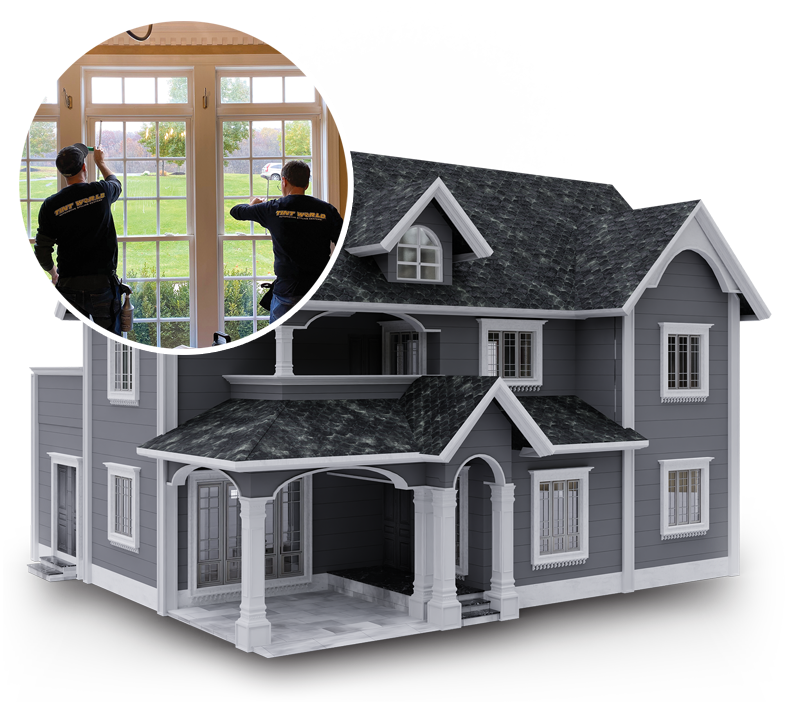Residential Window Tint: An Overview to Picking the Right Color
Residential Window Tint: An Overview to Picking the Right Color
Blog Article
How Residential Home Window Tinting Enhances Your Home's Energy Efficiency
Residential window tinting presents a compelling service for property owners seeking to boost power efficiency within their space. By using specialized movies to home windows, it efficiently minimizes heat transfer, thus supporting indoor temperatures and decreasing the need for extreme heating or air conditioning. This not only curtails energy consumption yet additionally gives a more comfortable setting by minimizing glow. Recognizing the nuances of exactly how tinting jobs and picking the ideal kind for your home can be essential. Strangely enough, what aspects should one think about prior to making this investment?
Understanding Home Window Tinting
Recognizing home window tinting is necessary for house owners seeking to improve both comfort and energy effectiveness in their living rooms. Residential Window Tint. Window tinting includes the application of a slim movie to the interior or exterior surface area of glass windows. This film can considerably regulate the amount of sunshine and warm that gets in a home, therefore affecting interior climate conditions
There are various types of window tinting films readily available, each with unique buildings. The performance of window tinting is usually measured by its Visible Light Transmission (VLT) percent, which indicates exactly how much light can pass via the movie.
Benefits of Energy Effectiveness
Home window tinting not just boosts aesthetic appeals but likewise plays a considerable duty in improving power effectiveness within household rooms. By minimizing warm transfer with home windows, colored films develop a much more steady indoor environment, which can cause substantial decreases in power consumption for heating & cooling. This power performance converts into reduced energy bills, providing homeowners with considerable long-term cost savings.

Additionally, home window tinting improves the convenience of living areas. By decreasing glare and obstructing harmful UV rays, colored windows create a more pleasurable setting, which can cause improved health for passengers. The protection versus UV rays likewise aids protect furniture and floor covering from fading, adding to the longevity of home things.
Exactly How Tinting Functions
Tinting movies operate via a mix of sophisticated materials and modern technologies designed to control the amount of solar power getting in a home. Largely made up of polyester, these movies commonly incorporate metal or ceramic bits that mirror and soak up warm. This double capacity enables them to dramatically minimize the penetration of ultraviolet (UV) rays and infrared radiation while permitting visible light to go through.
The effectiveness of window tinting is measured by its solar warm gain coefficient (SHGC), which suggests just how much solar power is transmitted through the window. Lower SHGC worths are better as they signify image source better warmth being rejected. Furthermore, window colors can feature a range of tones, enabling property owners to tailor their visual choices while improving power performance.
Furthermore, these movies work as an obstacle, stopping heat loss during colder months by reflecting interior warmth back into the home. This thermal insulation result complements the air conditioning benefits obtained throughout warmer months, adding to a well balanced interior climate year-round. By managing solar power efficiently, property home window tinting not just enhances convenience however also plays an essential duty in reducing energy consumption and decreasing energy costs.
Selecting the Right Tint

There are various types of home window films offered, including colored, metalized, and ceramic. Ceramic movies provide exceptional heat control without jeopardizing presence and are extremely resilient, making them a prominent selection.
Visible light transmission (VLT) is one more critical aspect, as it shows the quantity of all-natural light that can pass with the colored glass. Home owners need to select a tint with a VLT that enhances their lighting choices while still giving adequate glare decrease.
Furthermore, page evaluating the solar warmth gain coefficient (SHGC) can aid establish how well a tint can block warm from sunlight. A lower SHGC suggests better warmth control, eventually enhancing energy efficiency.
Installment and Maintenance Tips
Appropriate setup and upkeep are important parts in taking full advantage of the advantages of domestic home window tinting. Professionals additionally utilize specialized methods and devices, which can boost the durability and performance of the color.
Following installation, maintenance is important to prolong the life of the window movie. It is recommended to wait at least 30 days before cleaning up the colored home windows to permit the adhesive to treat completely.
Addressing these issues immediately can prevent additional damages and maintain power effectiveness. By adhering to these installment and upkeep ideas, home owners can guarantee their home window tinting continues to offer substantial power savings and convenience for years to come.
Final Thought
In verdict, household home window tinting acts as a reliable solution for improving energy effectiveness within homes. By lowering warmth transfer and obstructing dangerous UV rays, window films add to reduce power intake and boosted indoor comfort. The selection of appropriate tinting products, along with correct installment and upkeep, additionally makes the most of these advantages. Ultimately, window tinting stands for a lasting financial investment that not just decreases energy costs yet also advertises a comfy living environment throughout the year.
Window tinting involves the application of a thin film to the inside or exterior surface area of glass home windows. By decreasing this hyperlink warm transfer via windows, tinted films create a much more stable indoor climate, which can lead to considerable decreases in power intake for home heating and air conditioning.The effectiveness of home window tinting is determined by its solar warmth gain coefficient (SHGC), which suggests exactly how much solar energy is transferred through the window. By handling solar energy successfully, residential window tinting not just improves comfort but also plays a vital role in minimizing power consumption and reducing utility costs.
By minimizing warm transfer and obstructing hazardous UV rays, window films contribute to decrease energy intake and improved interior convenience.
Report this page